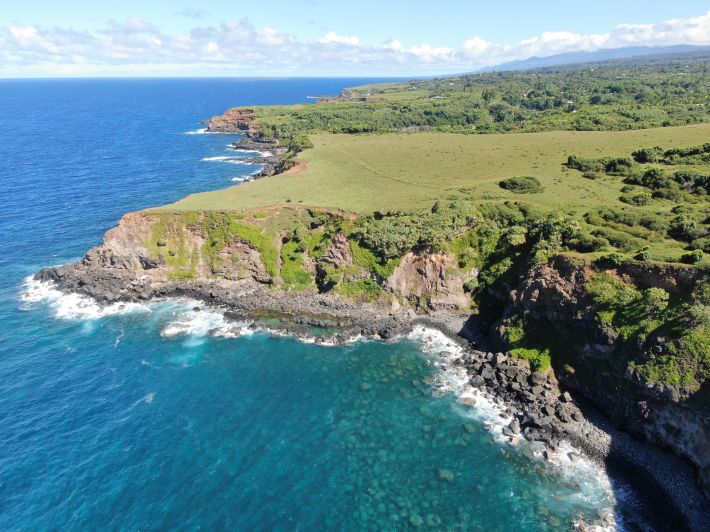Kamehameha Schools recently acquired 4,523 acres of land in the Kaupō moku of southeastern Maui for approximately $21 million. The property, known as Kaupō Ranch, spans the ahupuaʻa of Nāholokū, Waiū and the region of Kaupō Homesteads.
Kamehameha Schools has also acquired 1,053 acres within the Hāmākualoa district of north Maui for $13 million. This acquisition is comprised of three separate areas:
- East Kaupakulua, which totals approximately 277 acres located in the Haʻikū area of Maui, between Hāna Highway and the northern coastline of the island. These lands border Peʻahi, a well-known big wave surf spot on Maui.
- Kuiaha, which consists of approximately 161 acres along with agricultural land and gulches that have been used to grow pineapple crops since the early 1950s.
- Halehaku, which includes approximately 614 acres located in the Haʻikū area of Maui, between Hāna Highway and the northern coastline of the island. Most of the eastern portion of Halehaku is grassy pastureland.
“Kamehameha Schools’ ʻāina portfolio provides financial returns while allowing us to cultivate prosperous communities for keiki and ‘ohana. With an expanded presence on Maui, we have increased opportunities to work with Native Hawaiian communities and other organizations to support ʻāina-based education and partnerships, natural and cultural landscapes, agriculture and food systems, and other appropriate industries,” said Community and ‘Āina Resiliency Vice President Kā‘eo Duarte.
Once the center of culture and political power in traditional times, Kaupō is a favored place for agriculture and ranching, and in recent years growing ʻuala and raising cattle because of its nutrient-rich soils from Haleakalā lava flows. As new stewards of the lands, Kamehameha Schools will continue ranching, food production, guided hunting and ecotourism at Kaupō and explore educational opportunities for our Maui campus and community partners.
Moʻolelo tells us King Kekaulike repositioned the fertile Kaupō lands as Maui’s royal center during the 18th century. Kaupō is the site where Kamehameha was first recognized as a great warrior and given the name of Pai‘ea by the witnessing Maui chiefs and warriors. Traditional accounts suggest that Kaupō is where Hawaiians learned the art of fire making, and where kapa manufacture and design originated. During the Great Mahele, at least 11 ahupua‘a in Kaupō were claimed by the high chiefess Miriam Kekauʻōnohi, the great-granddaughter of Kekaulike. Chiefess Analea Keohokālole, great-granddaughter of Kame‘eiamoku and mother of King Kalākaua, also received lands in Kaupō. This intimate association between Kaupō and both the Maui and Hawai‘i Island ruling lines indicates the traditional importance of these highly productive agricultural lands.
Throughout the last 100 years, Kaupō Ranch Ltd has cared for the lands, maintaining the natural and cultural landscapes significant to Hawaiian people for centuries and ranching in sustainable ways that serve the community today.
“For many decades, our family, partners, and shareholders have stewarded Kaupō Ranch with a sincere appreciation of the unique sense of place and respect for the culture and lifestyle,” said Wendy Baldwin, whose family has been tied to Kaupō Ranch for generations. “It is a great comfort to know that, as the new owners of this land, Kamehameha Schools will preserve for future generations the traditions that make Kaupō special.”
Retaining the lands in Hawaiian ownership was part of Kamehameha Schools’ attraction to the property. Archaeological surveys indicate Kaupō is home to Maui’s second and third largest heiau, Pōpōiwi and Lo‘alo‘a, as well as seven others. The lands are home to an expansive network of traditional planting areas, a testament to the vast ‘uala fields that once dominated the landscape and served as Kekaulike’s economic engine during his reign at Kaupō. Improved access to wahi kūpuna would allow kānaka to reconnect to ‘āina, strengthening Hawaiian identity and spiritual well-being. Cultural practices could be furthered, including gathering marine and forest resources, kilo and wayfinding, traditional agriculture and protocol at heiau.
“Our stewardship of this land unlocks educational opportunities for our haumāna, kumu and the Native Hawaiian community,” said Dr. Scott K. Parker, po‘o kula of Kamehameha Schools Maui. “Our kula will have the ability to expand our ʻāina- and sustainability-based learning with cultural, environmental, scientific, career pathways, and other educational assets, helping our haumāna deepen their connection to Maui and strengthen their sense of place.”
Strategic investment in Hawai‘i lands is part of Kamehameha Schools’ kuleana. Ke Aliʻi Bernice Pauahi Bishop’s Last Will & Testament, recorded in 1883, advises her trustees to “reinvest the proceeds and the balance of [her] estate in real estate.”
In addition to these acquisitions, KS stewards approximately 364,000 acres of land across the pae ‘āina, including the Kamehameha Schools Maui campus in ʻAʻapueo and another 2,673 acres on Maui, mostly in agriculture in Lahaina.

Aerial view shows Puniawa Point which is part of Kamehameha Schools’ 1,053-acre land acquisition within the Hāmākualoa district of north Maui.
TAGS
ʻāina pauahi,
kamehameha schools,
maui,
'āina stewardship
CATEGORIES
Kaipuolono Article, Regions, Maui, Moloka’i and Lana’i, Themes, Culture, Community, Hawaii Newsroom, KS Hawaii Home, Kapalama Newsroom, Kapalama Home, KS Announcements, Maui Newsroom, KS Maui Home, Maui Athletics, Maui Elementary School, Maui Middle School, Maui High School, Maui Summer School, Outreach, Parents, Newsroom, Hawaii, Kapalama, Maui, Preschools, Alumni, Maui, Hawaii campus, Kapalama campus, Maui campus, Preschools
Print with photos
Print text only










